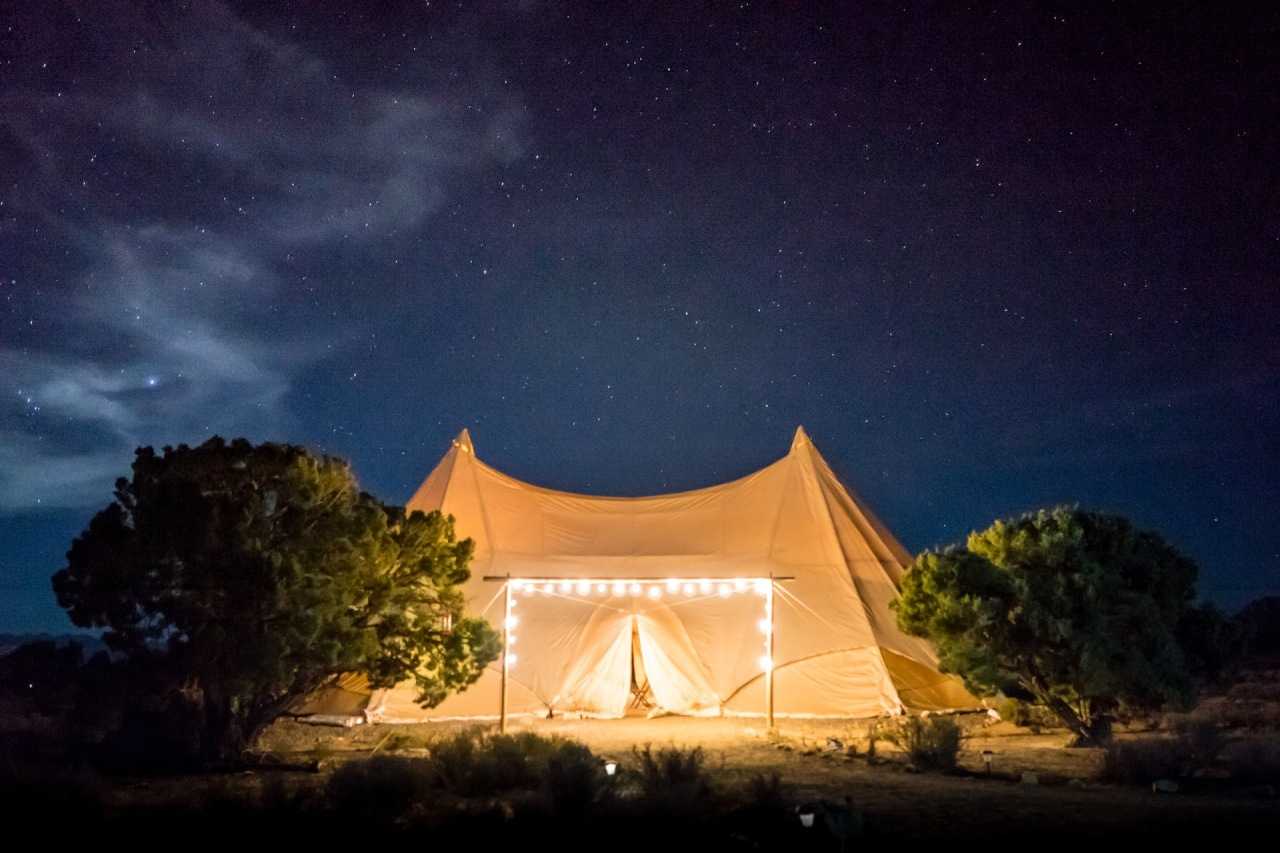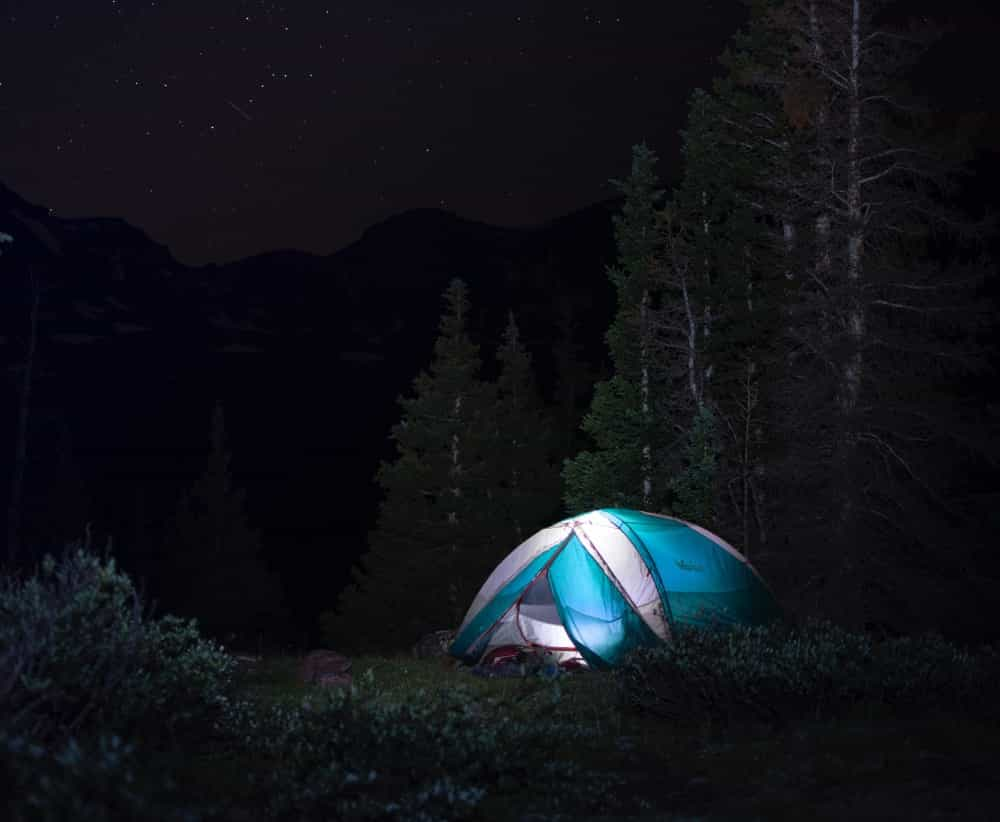Tent lights buying guide

Most camping trips will require you to bring along some form of lighting to help you find your way around your campsite and your tent after dark safely. A head torch or handheld torch is a useful piece of kit for things like finding your way to the toilet, and you may be able to transform it into a tent lamp by hanging it from a hook inside your tent. However, this can be fiddly and you’ll be reliant on just one source of lighting for everything – so for an easier time we recommend adding at least one tent light to your packing list.
What are the best lights for tents?
The best tent lighting depends on the style of camping you’ll be doing. If you’re just away for a weekend every now and then, you might like to keep things simple with a battery-operated torch and lantern. Keen campers, meanwhile, could add exterior as well as interior lighting, choosing from a range of lanterns, hanging lights and even fairy lights.
For more information on the various options and uses, see our full guide to camping lights.
How many tent lights do you need?
If space allows, we’d recommend you bring at least two sources of illumination. Choose a portable light – like a torch or headlamp – for walking to the toilets at night, plus a separate lantern or lamp for inside your tent. This way, you should always have light available for both inside and outside your tent, and you’ll have a backup if one fails, runs out of batteries or needs recharging.
What to think about when buying your tent lighting
Choosing tent lighting mostly comes down to whether you need to keep your setup simple (such as if you’re backpacking) or can afford (both in terms of cost and space) to go for something more elaborate. Factors to think about include the power source, bulb types, waterproofing, light strength and cost.
Power source
Solar An eco-friendly option, a solar-powered light generates energy from the sun during the daytime. While these are kinder for the environment, they’re not recommended when camping in seasons or countries with low levels of sunshine.
Battery The simplest option out there, battery-powered lights are the most reliable choice when you don’t have access to electricity at your campsite.
Rechargeable These types of lights are perfect for a short trip away. Remember to charge before you leave home if you haven’t booked a pitch with an electric hook-up or aren’t staying at a campsite with power in the communal areas.
Wind-up This form of lighting works in short spurts after you wind up the mechanism manually. It’s useful when you need temporary lighting, such as when getting ready for bed in the tent, or as an emergency backup.
Gas This option – usually used in lanterns – is cheap, gives off a bright glow and has a long burn time. It also emits heat so can make your tent cosier in cold conditions. While modern gas lanterns are much safer than older models, they’re not recommended for long-term use inside your tent, especially when camping with kids.
Electric Most camping lights won’t rely on a grid power source. However, it’s possible to use wired outdoor lights if you have access to an electrical connection at your pitch.
Waterproofing
Tent and outdoor lights usually come with an IP rating that will show you how weatherproof they are. Opt for a rating of at least IP44 for inside and outside your tent.
Light strength
If you’re purchasing a torch, a model with 35 to 60 lumens of power should suffice. When looking to illuminate a larger area, like a six-man tent, go for lighting with a lumen count of 100 or higher.
Cost
Tent lights range from a couple of pounds for a small low-intensity keyring torch to around £100 for heavy-duty lamps suitable for more regular or extreme usage. The latter will usually be made from robust waterproof and dustproof materials. If you’re opting for a pricier camping light, look out for additional settings like night vision mode, dimming functions and long battery life. Generally, the higher the price, the more features will be included in the design and the more durable they should be.
Tent lighting tips
There are all sorts of handy tent lights on the market, with features you may not have considered – and there are DIY options too!
-
Pop a torch or headlamp into a clear plastic bottle or container to create a DIY camping light for inside your tent.
-
If you’re short on space, buy a collapsible lamp to save room in your pack.
-
Some tent lights double up as insect repellers – ideal when camping in environments with lots of mosquitoes or midges.

7 of the best tent lights to buy
There are hundreds of tent lighting options on the market, so it can all seem a bit bewildering – even once you’ve taken into account all the factors listed above. To help narrow down the choices a little, we’ve selected some of the best tent lights currently available, covering a range of price points and usages.
1. Vango Lunar 250 Eco Recharge USB
The solar-charging aspect of the Vango Lunar 250 Eco Recharge USB makes it an eco-friendly option, and an ideal option for sunny summer travels. It’s also got backup in the form of a rechargeable battery, though – so don't worry if you encounter a cloudy day.
Pros:
-
Two power options for extra versatility
-
Sturdy design with hanging hook
-
High lumen count of 250
-
Doubles as a phone charger
Cons:
-
Limited run time
2. Coleman Duo Panel Light Lantern
The Coleman Duo Panel Light Lantern is a sturdy and incredibly versatile piece of kit, with two removable lighting panels and a choice of lighting modes and strengths. It’s suitable for outdoor use as well, as it’s able to withstand light rain.
Pros:
-
Versatile removable panels with magnets for hanging in your tent
-
Splash resistant and suitable for use in light rain
-
Long run time (up to 200 hours on low mode)
Cons:
-
The D batteries needed can be hard to find in shops
3. Eurohike 12 LED Lantern
The Eurohike 12 LED Lantern is a classic lantern-style light that makes a great choice for beginner or occasional campers. Costing less than £10, there are few fancy features here but it’s a reliable lamp that gives off a decent 30-lumen light.
Pros:
-
Affordable price
-
Dimmer function
-
Runs for up to 12 hours
Cons:
-
No built-in recharge function
4. Biolite Alpenglow 500
For those who are likely to do longer camping breaks, it’s worth spending a bit more on your tent lights, and the rechargeable Alpenglow 500 has become a popular choice at the higher end of the price range. It’s a bit chunkier than some other options on the market, so it’s best used for the kind of break where you’ll be in one place for a few days – and that will also give you a chance to use all the different functions (including warm/cool light options and a colour-changing function for party night).
Pros:
-
Waterproof and multifunctional
-
Long run time (up to 200 hours on low)
-
Can be used as a phone charger
Cons:
-
Fairly heavy at 380 grams
5. Luci Lights Lux Solar Inflatable Light
This is a clever little lamp indeed – it weighs in at just 125 grams, but it’s strong, bright, waterproof and easy to charge using solar power. The warm white light is more attractive than the harsh glow of some tent lights, with 10 LEDs giving out 65 lumens of light.
Pros:
-
Waterproof (rated IP67)
-
Full recharge in 7 hours using solar power
-
Collapses down to 2.5cm in height for easy packing
Cons:
-
No electrical or battery backup for less sunny days
6. Outdoor Revolution 2-in-1 Lantern & Mosquito Killer
Multifunctional items are ideal for camping, allowing you to save space both in your luggage and in your tent – and that’s even more important if you’re doing a hiking and camping trip where you’ll have to get all your kit into one bag. This handy little lamp is a great example – hang it in your tent and it will provide up to four hours of light, plus 30 hours of use as an insect repellent.
Pros:
-
Has a hook for hanging inside your tent
-
Rechargeable in three hours
-
Water resistant
Cons:
-
Can be awkward to clean bugs from the insect repeller
7. Mountain Warehouse Wind Up Lantern
Rechargeable batteries and solar power are clever features on many tent lamps, but there may well be times when you don’t have access to either power source – especially if you’re wild camping. That’s where this good old-fashioned wind-up lantern comes into its own: you’ll be able to get light out of this even in the middle of the night and the middle of nowhere. It’s also a useful backup to have on hand if your main lighting option fails (or for a power cut at home).
Pros:
-
Not reliant on having battery or electric power
-
Waterproof design that can be used in all weathers
-
20 minutes of light for a minute of winding up
Cons:
-
A little bulky for packing in a hiking backpack
Ready to go?
Tent lights may be fairly small things, but they can make a huge difference to the convenience, comfort and safety of your camping trip, so it’s worth taking time to find the right ones for your needs. If you need help selecting other bits of kit for your camping trip, take a look at the buying guides included in the Pitchup camping guide, which has advice on all sorts of equipment from tent pegs to camping chairs – as well as the tents themselves, of course.
All kitted out and ready to go? Now you’ll just need a place to stay – and Pitchup has plenty of excellent campsites to choose from around the UK and Europe, with easy booking and genuine reviews from previous customers.
Tent lighting FAQs
Can you put LED lights in a tent?
Yes, you can put LED lights in a tent. They’re actually safer than other types of bulbs as they give off some heat but not as much as classic fluorescent lights, which are a potential fire hazard. Energy efficient and long lasting, LED bulbs offer the best lighting for tent camping.
How many lumens do you need in a tent light?
For an average-sized tent – around a four-berth model – you’ll need around 50 to 100 lumens. If you have a bigger eight-man tent, go for a camping lamp of approximately 150 to 250 lumens or more.
What colour lighting is best for camping?
It’s up to personal preference, but some people like to use red lights for getting around after dusk. This is because our eyes are less sensitive to this colour, so you’ll be able to see in the dark without it affecting your natural night vision. Avoid blue tones as insects are drawn to these shades.
Is it safe to use fairy lights in a tent?
It’s safe to use string lights in a tent, but opt for outdoor fairy lights as they’re more robust. Condensation can build up inside tents, so it’s important to make sure your lights are waterproof – this means you can use your lights outside too if you want to. Look for an IP rating of at least 44 for camping.